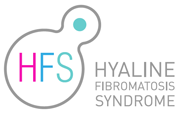Nodule formation
As described in detail in other sections, HFS is a severe autosomal recessive disease linked to loss of function mutations in the gene cmg2. Patients present subcutaneous nodules, gingival hypertrophy and joint contracture leading to severe loss of mobility, with episode of diarrhea an increased sensitivity to pulmonary infections in the most severe form of the disease.
The subcutaneous nodules are the most debilitating aspect of the disease, and are a clear hallmark of the disease. They tend to develop over the first months of life, presumably over point of repeated mechanical stress or following mechanical injury. The nodules seem to be rather acellular, essentially containing eosinophilic extracellular matrix components. The nodules localization might reflect a disregulation of repair mechanisms induced by microtrauma (1).
The nodule composition is poorly described, but an increase in collagens and glucosaminoglycans (GAGS) (2, 3, 4, 5) are often reported. Indeed, collagen I and IV seem to be more abundant in nodules than in unaffected tissues (6). In contrary, it seems that hyaluronic acid level is depleted in nodules compared to the non-affected skin of the same patient; a lower expression of hyaluronic acid synthase might explain this observation (7).
The root of HFS pathogenesis seems to be a disregulation of the ECM synthesis and/or degradation. However, the role of CMG2 in this process is still unknown and it is crucial to decipher its function to understand better the disease and find ways to treat it.
(1) Urbina et al, 2004 (2) Kitano et al, 1972 (3) Breier et al, 1997 (4) Iwata et al, 1980 (5) Tzellos et al, 2009 (6) Tanaka et al, 2009 (7) Tzellos et al, 2009




